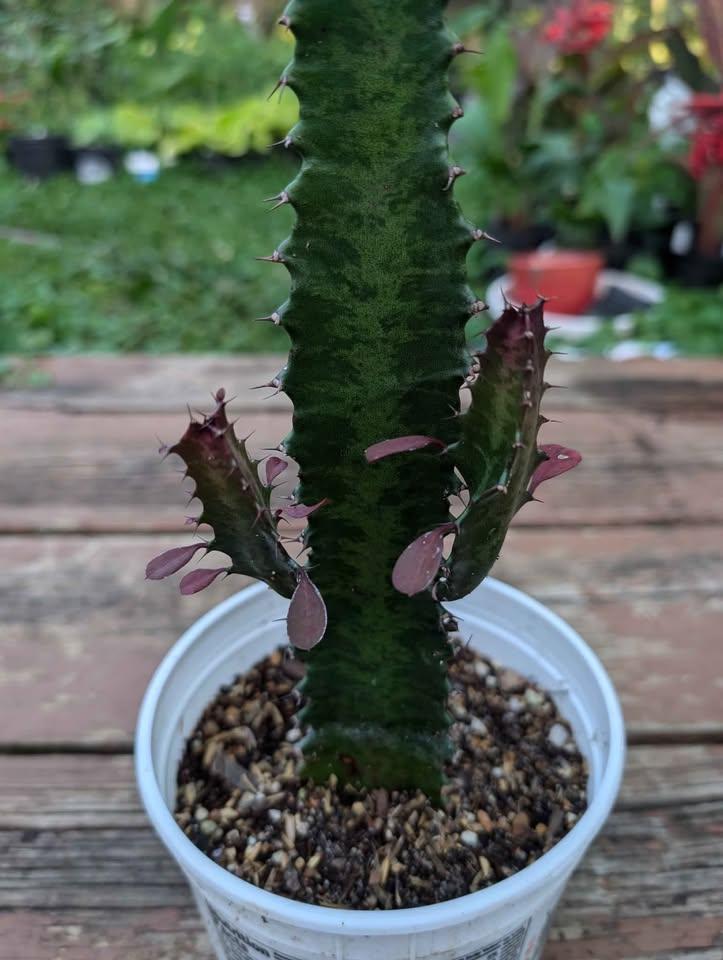African Milk Tree “🌵✨ Euphorbia trigona ‘Rubra– The Elegant Red-Edged Succulent
Euphorbia trigona ‘Rubra’, commonly known as the African Milk Tree Rubra or Red African Milk Tree, is a stunning, upright succulent native to Central Africa. It is a cultivar of the green Euphorbia trigona, with distinctive reddish to deep burgundy hues along its vertical stems and leaves.
Known for its candelabra-like form, vibrant colors, and ease of care, this plant is popular in indoor collections and drought-tolerant landscapes. Its rapid, vertical growth and bold architectural shape make it an excellent statement piece for homes, offices, and patios.
🌿 Botanical Overview
Scientific Name: Euphorbia trigona ‘Rubra’
Common Names: African Milk Tree Rubra, Red African Milk Tree, Cathedral Cactus (misleading, as it’s not a true cactus)
Family: Euphorbiaceae
Origin: Central Africa
Growth Habit: Tall, columnar, branching succulent
Size:
Height: Up to 1.5–2.5 meters (5–8 feet) indoors, taller outdoors
Spread: 45–60 cm (18–24 inches)
Stems: Triangular cross-section, upright with spiny ridges
Color: Deep green to burgundy-red stems with contrasting red or purple leaves
Leaves: Small, teardrop-shaped, grow along ridges, and drop seasonally
USDA Hardiness Zones: 9–11
☀️ Sunlight and Temperature Requirements
Sunlight:
Prefers bright, indirect light to full sun
Indoors: Best near a south or west-facing window
Outdoors: Thrives in partial to full sun, with acclimation to avoid sunburn
Temperature:
Optimal range: 18°C to 27°C (65°F to 80°F)
Not frost-tolerant: Protect from temperatures below 10°C (50°F)
Sudden temperature drops or drafts can cause leaf drop
🌞 More light intensifies the rubra (reddish-purple) coloring, while lower light may result in greener stems.
💧 Watering Routine
Growing Season (Spring to Early Fall):
Water when the top 5 cm (2 inches) of soil is dry
Usually every 10–14 days, depending on light and temperature
Always water deeply and let excess water drain completely
Winter Dormancy:
Reduce watering to once every 3–4 weeks
Avoid watering if the plant is in cool conditions and the soil remains moist
💧 Overwatering can cause root rot, the most common issue for this species.
🌱 Soil Requirements
Type:
Requires well-draining soil, typically a cactus or succulent mix
Optional mix:
50% succulent soil
25% coarse sand
25% pumice or perlite
pH: Neutral to slightly acidic (6.0–7.0)
Fast drainage is crucial to avoid moisture accumulation at the roots.
🌾 Fertilizing Schedule
During Active Growth:
Fertilize every 4–6 weeks in spring and summer
Use a diluted, balanced succulent fertilizer (e.g., 10-10-10 or 5-10-10)
During Dormancy:
Do not fertilize in winter
Avoid overfeeding, as excessive nutrients can encourage weak, leggy growth.
✂️ Pruning and Maintenance
Pruning:
Prune to control height, encourage branching, or remove damaged stems
Always wear gloves — the plant exudes a milky sap that is toxic and can irritate skin and eyes
Use sterile, sharp tools
General Maintenance:
Rotate periodically to ensure even growth
Dust off stems gently to allow optimal photosynthesis
🌿 Propagation
By Cuttings:
Cut a healthy stem with a sterile knife or pruner
Allow the cutting to callous for several days to a week
Plant in dry, well-draining soil
Water lightly after the cutting has rooted (typically after 2–3 weeks)
Safety Tip:
The sap is toxic — always handle with gloves and keep away from pets and children.
🐛 Pests and Problems
Common Pests:
Mealybugs
Spider mites
Scale insects
Diseases:
Root rot due to overwatering
Fungal spots if kept in excessive humidity
🛡️ Treat pests with neem oil or insecticidal soap. Ensure good air circulation and avoid stagnant moisture.
🌸 Flowering and Decorative Value
Flowers:
Rarely blooms indoors; if it flowers, blooms are small and insignificant
Grown primarily for its striking coloration and form
Decorative Uses:
Stunning in modern interior decor
Ideal for offices, patios, and succulent gardens
Works well in minimalist or desert-themed arrangements
📸 Its upright growth and vibrant red tones make it a sculptural focal point in any space.
✅ Conclusion
Euphorbia trigona ‘Rubra’ (African Milk Tree Rubra) is a low-maintenance, visually dramatic plant perfect for indoor spaces and warm climates outdoors. Its rapid growth, easy propagation, and bold coloring make it a favorite among succulent enthusiasts.”





Reviews
There are no reviews yet.